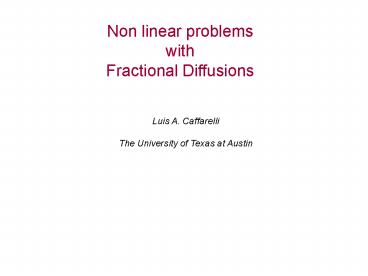Non linear problems - PowerPoint PPT Presentation
1 / 43
Title:
Non linear problems
Description:
Fluid dynamics like in the quasi-geostrophic equation ... i) The quasi-geostrophic equation. See also:Kiselev, Nasarov, Volberg, arXiv.org'06 ... – PowerPoint PPT presentation
Number of Views:27
Avg rating:3.0/5.0
Title: Non linear problems
1
Non linear problems with Fractional Diffusions
Luis A. Caffarelli The University of Texas at
Austin
2
- Non linear problems involving fractional
diffusions - appear in several areas of applied mathematics
- Boundary diffusion (see for instance Duvaut and
Lions) - or more generally calculus of variations when
the energy - integrals involved correspond to fractional
derivatives. - Fluid dynamics like in the quasi-geostrophic
equation - modeling ocean atmospheric interaction, or in
the case of - turbulent transport
- Stochastic processes of discontinuous nature
(Levy processes) in - applications for which random walks have jumps
at many
3
4
(No Transcript)
5
(No Transcript)
6
(No Transcript)
7
(No Transcript)
8
(No Transcript)
9
(No Transcript)
10
(No Transcript)
11
(No Transcript)
12
(No Transcript)
13
Remark the work just described is strongly based
in an extension theorem It identifies the
fractional Laplacian of a given function u(x) in
Rn with the normal derivative of an extension
v(x,y) of u(x) into the upper half space, (ygt0),
of Rn1.
14
The classical example is the ½ Laplacian If v
is the harmonic extension of u ( convolution with
the Poison kernel), then the normal derivative
of v at y0 is exactly the half Laplacian of u.
15
In particular, u being half harmonic simply
means that v is harmonic across y0, reducing
regularity properties of u to those of the
harmonic function v
16
In fact, any other fractional power of the
Laplacian of a given function u(x) can be
realized as the normal derivative of an
appropriate extension v(x,y).
This can be interpreted as an extension into a
space of fractional dimension and suggest the
correct form of homogeneous solutions,
monotonicity formulas, truncated test functions,
etc
17
- This harmonic extension has the virtue of
- reducing many global issues and arguments
- to local, more familiar methods of the
- calculus of variations.
- The global properties of the solutions are
- somehow encoded in the restriction of the
- extension v(x,y) to unit ball in one more
- dimension. (L.C and L.Silvestre, arXiv.org,
07)
18
i) The quasi-geostrophic equation
19
See alsoKiselev, Nasarov, Volberg, arXiv.org06
20
ii) Problems with constrains or Free
Boundary problems
21
(No Transcript)
22
(No Transcript)
23
iv) Random Homogenization
24
See the work of D. Cioranescu and F. Murat (1982)
where the Homogenized equation was derived for
periodic media.
25
Fully non-linear equations with fractional
diffusion
26
(No Transcript)
27
. . .
28
(No Transcript)
29
(No Transcript)
30
(No Transcript)
31
.
Formally, the solution u0 to a fully non-linear
equation, its first derivatives and its second
derivatives all satisfy equations or
inequalities like (1) above. This implies that
u0 is classical (Evans Krylov)
32
(No Transcript)
33
(No Transcript)
34
(No Transcript)
35
(No Transcript)
36
(No Transcript)
37
(No Transcript)
38
(No Transcript)
39
(No Transcript)
40
(No Transcript)
41
(No Transcript)
42
(No Transcript)
43
Thank you for your attention































